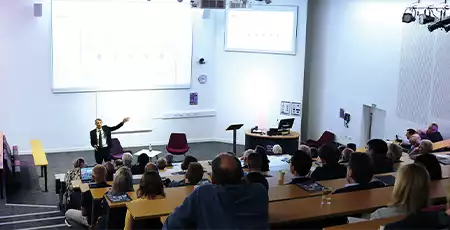Productivity shift
Bart van Ark extols the virtues of a strategic productivity course for business leaders.
Facing a host of everyday challenges, it is little surprise that productivity struggles to reach the top of the business leader’s in-tray.
It’s widely acknowledged as important but often in a vague, abstract way. So what exactly is productivity? Why does it matter? And, crucially, what practical steps can a business take to improve it?
The launch last year of a series of both open and customised executive education programmes at AMBS has shown the tremendous value of getting executives to think differently about productivity and put it nearer the top of their agendas.
One of the most striking things I’ve observed since we started running the courses is how, over just a few days, business leaders very quickly start to shift their perspectives on the topic. Stepping away from their offices for a few days week and being immersed in thinking about how productive they are as a business or organisation can really be quite transformative.
What delegates also quickly come to understand is that productivity is a journey, and that being productive is mostly about better joining up things that companies are already doing. That’s why, at the end of the week, we ask each participant to develop a single initiative to improve productivity in their business.
Network
A key strength of these executive programmes is also the peer-to-peer networking, which can be incredibly powerful. As facilitators we can provide the content and leverage the wide knowledge on productivity that exists among our academics and thought leaders both here at AMBS and at The Productivity Institute (TPI). But delegates then engage with each other to discuss what this means for their everyday challenges. We’ve seen these conversations flourish into meaningful exchanges of insight and support.
As part of the course we also organise an offsite visit so that leaders can see productivity in action, and attendees find this very rewarding. For instance, on our last course we organised a visit to Carrs Pasties in Bolton, a firm which really lives and breathes productivity and sees the benefits. This visit helps bring the course content to life in a tangible and inspiring way.
Delegates quickly come to understand that productivity is a journey and that being productive is mostly about better joining up things that companies are already doing.
Compelling narrative
Our course chimes with the broader need for business leaders to create a compelling story about why productivity is important. This involves understanding its key drivers and finding ways to connect different aspects of productivity improvement in the boardroom.
Interestingly, surveys and interviews with business leaders indicate that productivity is not consistently used as a key performance indicator (KPI), particularly at the organisational level. Yet with the huge advances in data technologies, almost every part of the production process can now be measured for efficiency. Real-time big data and data processing technologies, including artificial intelligence to predict patterns and address potential issues before they arise, offer vast opportunities for business to raise productivity.
But when we look at productivity at the organisational level, it's about more than just the efficiency of the production line or service delivery. Organisations have many people and resources that aren't directly involved in production but who can still play a crucial role in creating value.
Productivity puzzle
It's often said that there is no silver bullet to the productivity puzzle and this is true, not only for the slow productivity growth across the broader economy, but also to improving productivity within a business. Indeed, TPI research on strategic productivity has identified five key drivers that help businesses navigate the complexity of productivity improvement in a holistic and sustainable way.
First, the importance of leveraging the latest technology and innovative ideas which can streamline operations and enhance products. Second, having a team that's not only skilled, but also healthy, motivated and engaged. Third, effective leadership and agile management practices that foster a culture of productive behaviours. Fourth, clear and engaging communication, both internally and externally to drive the value for customers. And finally, mobilising the necessary funds to invest in growth, innovation and continuous improvements.
I would urge any business that needs to improve their productivity in order to become more competitive to join with us to help them on their productivity journey, and I encourage any business striving to boost its performance and enhance its competitiveness to think strategically about productivity.
“Delegates quickly come to understand that productivity is a journey and that being productive is mostly about better joining up things that companies are already doing.”
Find out more about the Strategic Productivity short business course.
Tags:






